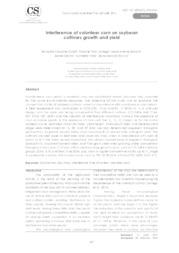Interference of volunteer corn on soybean cultivars growth and yield.
Interference of volunteer corn on soybean cultivars growth and yield.
Author(s): CARATTI, F. C.; LAMEGO, F. P.; BIANCHI, M. A.; CECHIN, J.; FARIAS, H.; SILVA, B. M. da
Summary: Spontaneous corn plants in soybean crop are considered weeds because they compete for the same environmental resources. The objective of this study was to evaluate the competitive ability of soybean cultivars when in coexistence with spontaneous corn plants. A field experiment was conducted in CCGLTEC, Cruz Alta/RS, in 2014/15, in a split-plot design, with the main plot being composed of four different cultivars (CD 2694, BMX 7166, TEC 5718, TEC 6029) and the subplots of interference conditions (without the presence of corn volunteer plants, in the presence of corn until the V3, V6, V9 stages, or for the entire soybean cycle. Leaf area, shoot dry mass, plant height, chlorophyll index, and development stage were determined at 15, 30, and 49 DAE; we also determined apparent biological productivity, apparent harvest index, and components of productivity and grain yield. The cultivars showed losses in leaf area and shoot dry mass when in coexistence with corn (8 plants m-2) in the three periods evaluated. All cultivars showed losses in apparent biological productivity, apparent harvest index, and final grain yield when growing under competition throughout the cycle. Cultivars with a medium/long growth cycle, such as CD 2694 (maturity groups (GM): 6.9) and BMX 7166 (GM: 6.6), show a higher competitive ability up to V9 stage in contrast to cultivars with a short cycle, such as TEC 5718 (GM: 5.9) and TEC 6029 (GM: 5.7).
Publication year: 2018
Types of publication: Journal article
Observation
Some of Embrapa's publications are published as ePub files. To read them, use or download one of the following free software options to your computer or mobile device. Android: Google Play Books; IOS: iBooks; Windows and Linux: Calibre.
Access other publications
Access the Agricultural Research Database (BDPA) to consult Embrapa's full library collection and records.
Visit Embrapa Bookstore to purchase books and other publications sold by Embrapa.

